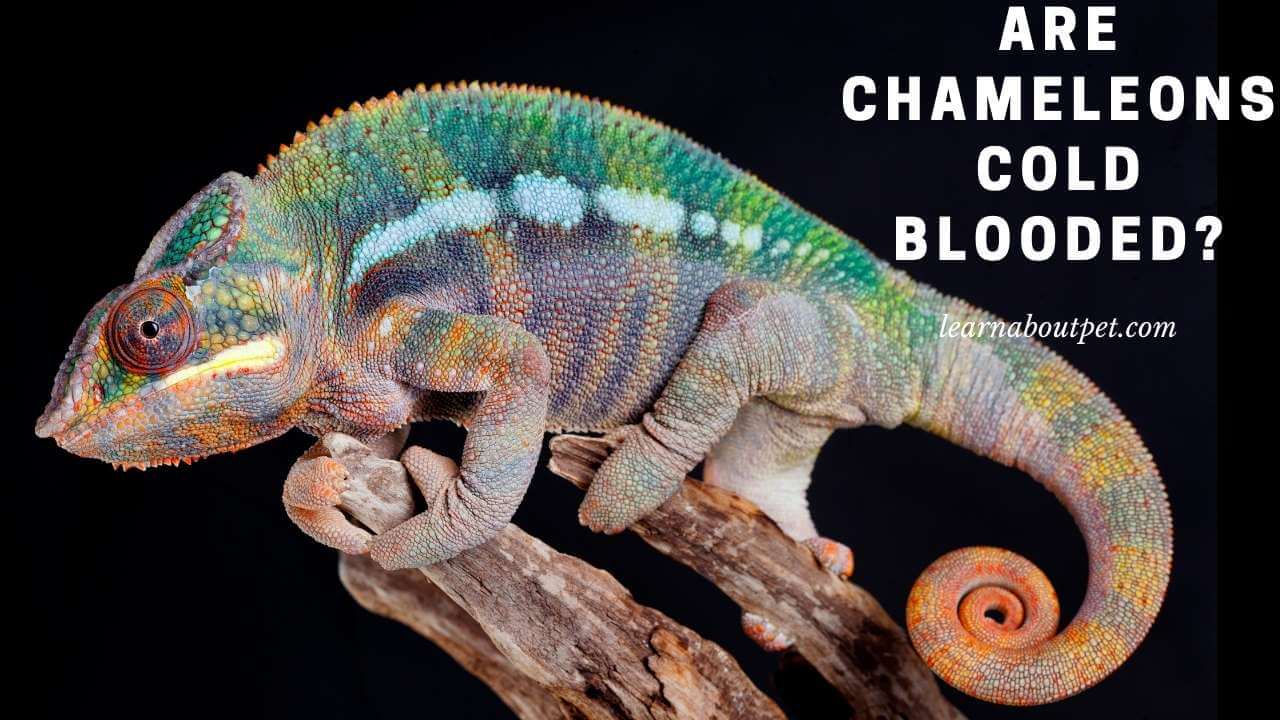When you are going to own pets, you must know that this pet is warm-blooded or cold-blooded. It is essential to see this thing because when you know this thing, you will be able to give them temperature accordingly. Some animals belong to the warm-blooded category, and others belong to the cold-blooded.
Are chameleons cold blooded? Yes, they belong to a cold-blooded category of animals. But this doesn’t mean they have cold blood in them. Cold blood means that they cannot control their body temperature when there is any change in the environment.
This article will discuss are chameleons are warm or cold-blooded, the difference between cold-blooded and warm-blooded animals, chameleon night temperature, and how we can warm chameleons, and many other things like these things. Let’s dive into the details of this topic.

Cold-Blooded Animals Vs Warm Blooded Animals
Before owning any pet, you must know its features and its entire genetic lineage. In this way, you can save your pet from getting different issues.
Cold Blooded Animals
These animals can’t maintain their body temperature when there is any change in the surrounding environment then. These animals are called cold-blooded animals. It is very critical for them to survive in extreme or harsh climatic conditions. Fishes and reptiles belong to this category.
Warm-Blooded Animals
These are the animals that can maintain the body temperature and maintain internal body temperature. When there is any temperature fluctuation in the environment, then these animals are known as warm-blooded animals. They can survive in extreme temperatures because of this feature. These animals are adaptable to any environment. Humans, birds, and mammals belong to this category.
There are many differences between warm-blooded and cold-blooded animals. We will discuss all of them in the following.
- Animals like reptiles, fishes, and invertebrates belong to cold-blooded animals. They are not able to maintain their body temperature according to the environment. When there is any change in the external environment, they are not adaptable to this change and get some issues. When we talk about warm-blooded animals, we say that they can adjust themselves to the environment when there is any change. They are adaptable to harsh conditions. They have much more energy compared to cold blooded animals.
- In cold-blooded animals, the temperature and metabolism change according to the environment. In warm-blooded animals, they can survive with environmental fluctuation. They can adjust themselves to the harsh conditions.
- Cold-blooded animals have two types of phases that are aestivation and hibernation. Aestivation is the sleeping phase in the summer season, and hibernation is the sleeping phase in winter conditions. They do these phases when there are unfavorable conditions in the external environment.
- Cold-blooded animals can defend themselves from the parasite’s attack. They can also defend them from infections and various other harmful things. On the other hand, warm-blooded animals have a sound immune system that makes them defend themselves from getting issues.
- Hence we can conclude that warm-blooded animals can maintain body temperature when there is any change in environment, but cold-blooded animals cannot do so.
Are Chameleons Cold-Blooded?
Yes, they are cold-blooded, and they don’t maintain their body temperature when there is any change in the environment. Cold-blooded doesn’t mean they contain cold blood. It’s biological terms that distinguish the animals based on temperature adaptation. Chameleon heating should be done in a cage or habitat.
Are Chameleons Warm Or Cold-Blooded?
Chameleons belong to cold-blooded animals. They are not able to maintain the body temperature when there is any change in the external environment. Like when there is a high temperature in the external environment, they cannot maintain an internal temperature. That is why they go for hibernation and other processes like this.
Are chameleons cold blooded? They are not warm-blooded animals because they can’t maintain body temperature constant when the temperature fluctuates. Are chameleons good pets? Yes, they are good pets, but one thing in mind is that you should take care of cold-blooded pets because they cannot survive in extreme weather conditions.
Why Are Chameleons Cold-Blooded?
Are chameleons cold blooded? Reptiles fall under the category of cold blooded animals. It means that they can’t keep their body temperature constant according to the environment. They have less energy for metabolism that is why they don’t preserve the metabolic heat.
What Happens If A Chameleon Gets Cold?
Chameleons are cold blooded animals, and they are not very effective in harsh weather. When there is extreme weather, they cannot survive in this extreme condition and hence result in not working. This may be dangerous for chameleons.
How Do Chameleons Stay Warm?
The chameleon temperature should be in between the optimum temperature range. As we know that they are cold-blooded, we should take some measures to reduce the temperature in an extreme environment. They cannot preserve metabolic heat, but they get heat from their surroundings. You can give them heat from the heater and make them warm.

How To Maintain Body Temperature For Chameleon Pets?
Many ways are there to maintain the body temperature of pets like a chameleon. They can get heat from basking. You can also use the heater to make them warm.
Basking Heat
You can make them warm by giving them basking heat. In this way, they absorb heat from their surroundings, which is a natural way to get heat. You can use the heat lamp to give them heat. Proper or optimum temperature is necessary for chameleons.
They are not able to make heat from metabolism. That is why you should take some measures to make the chameleon warm. You can set the temperature of the lamp in a way the chameleon doesn’t get any issue because of extreme conditions.
Basking Chameleon heat temperature needs to be at an optimum level for the chameleon to grow fast and healthy.
Light And Heat
- You can give them optimum temperature in habitat to save them from getting issues. There should be cold as well as warm sides in the habitat. The temperature of the cold area should be seventy to eighty Fahrenheit, and it is twenty-one to twenty-seven in Celsius.
- On the warm side, the temperature should be eighty to eighty-five Fahrenheit, and it is twenty-seven to twenty-nine degrees on the Celsius scale. You can adjust the temperature by using a separate thermometer.
- At night, the temperature of the habitat must be sixty-five to seventy Fahrenheit. It is the best temperature for them at night.
- Reptiles need about twelve hours of dark or light cycle. You can use a fluorescent bulb to give the rays to a chameleon that is good for calcium absorption.
- Humidity in habitat is also significant. Humidity should be between sixty-five to eight percent. Use a hydrometer to measure the humidity level.
- Habitat should have a drip system, automatic fogger, and mister.
How Is Cold Too Cold For A Chameleon?
They need a temperature that is okay for them, and this temperature is known as optimum temperature. There are different temperatures for different animals. Chameleons need a basking place, and temperatures of eight to ninety Fahrenheit and the habitat temperature should be 70-82 Fahrenheit.
Is It Normal For Chameleons To Be Cold?
Are chameleons warm or cold blooded? Yes, it is normal for the chameleon to be cold because they cannot generate metabolic heat, and they get the heat from their surroundings. As the body temperature of humans is 98.6 degrees; and any fluctuation in this temperature result in serious issues. The same thing is for chameleons also. You can give them enough heat that is suitable for them.
Are Jackson Chameleons Cold-Blooded?
Yes, Jackson’s Chameleons fall under the cold blooded category. It would be best if you gave the optimum temperature to a chameleon. The optimum temperature for a chameleon is between seventy to eight-four Fahrenheit.
Do Chameleons Need Heat At Night?
Yes, they need heat at night because at night there is low temperature. The temperature should be between sixty-five to seventy Fahrenheit in the habitat. It is important to give light to them. The humidity level in the habitat is also very essential. You can set the humidity level by measuring it with a hygrometer.
What Temperature Does A Chameleon Need?
The ambient temperature of chameleon is between 75 to 85 F. the basking spot should be 10 degrees higher than ambient temperature. The seventy-degree temperature of the cage is okay for chameleons.
Higher or lower temperatures can harm your pet chameleon teeth and health. That is why you need to know the temperature for a pet that you want to own.
Do Chameleons Need Heat Lamps?
Yes, they need a heat lamp at night or a low temperature outside the environment. They need to provide a heat lamp because a heat lamp will provide the energy. They do not produce metabolic heat. That is why an external energy source is essential.
You should know the optimum temperature of a chameleon. After that, you can set the temperature with a thermometer. Chameleons cannot produce heat by themselves. They get heat from their surroundings. Many ways are also there, like the sun. They can also get heat from the sun; this is a natural way of getting heat.
If there is no sun due to weather conditions, you can give them heat by using a heat emitter. They are ectothermic animals, and they live in sweltering climate conditions. But they don’t maintain the body temperature. That is why they need external heat. On the other hand, cold-blooded animals maintain their body temperature when there is any temperature fluctuation in the external environment.
Many other reptiles are also there that can warm their body like snakes, but chameleons receive heat from the sun or any external source. When chameleons are in the wild, they can get heat from the sun only, but when they are in captivity, they can get heat from the source you are using to provide the heat.
A heat lamp is the best instrument when they are in captivity. You can also use sun and let them out of habitat for basking if they are not getting any issues. You can place the heat lamp on the top of the cage. You can set the temperature at about ninety to ninety-five Fahrenheit. If you have a baby chameleon, then you can set the temperature a little bit lower.
How Would I Know If a Chameleon Is Cold?
When you own a pet, then you are familiar with him. Pet will tell you many things about his behavior, and you will be able to understand the language of your pet. One of the essential things is coloring in chameleons.
Chameleon is famous for many things like long sticky tongues, and the essential things are color change. When they are too cold, then you will see that their temperature changes to darker. They are doing this because it will allow them to absorb more heat from their surroundings. It is a fact that dark colors absorb more heat and vice versa. That is why their temperature changes.
The dark color is also associated with many other things. Like when a chameleon is suffering from some diseases or has some issues, their color changes to darker. That is why you need to check the temperature. If the temperature is okay, then respond to them accordingly.

Final Verdict – Are Chameleons Cold Blooded
So, are Chameleons cold blooded? Chameleons are definitely cold-blooded animals. It doesn’t mean that they have cold blood in them. They are not able to maintain their body temperature when there is any change in the external environment.
They don’t produce metabolic heat. That is why they absorb heat from the sun when they are in the wild. When they are in captivity, then they can get heat from external sources like a heat lamp.

Welcome to Learn About Pet. My name is Rajkumar Ravichandran and I love all pets, travel, and amazing food. I write about my passion and personal experience caring for multiple pets in this blog! ❤️
Post Disclaimer
DISCLAIMER: THIS BLOG OR WEBSITE, "Learn About Pet", DOES NOT PROVIDE YOU WITH MEDICAL ADVICE AND IS NOT A SUBSTITUTE FOR MEDICAL ADVICE. ALWAYS GET IN TOUCH WITH YOUR PERSONAL VETERINARIAN AND USE INFORMATION HERE AS GENERAL ADVICE.
The information, including but not limited to, text, graphics, images and other material contained on this website are for informational purposes only. No material on this site is intended to be a substitute for professional veterinary advice, food recommendation, diagnosis, or treatment. Always seek the advice of your veterinarian or other qualified health care provider with any questions you may have regarding a medical condition or for pet food related questions.







